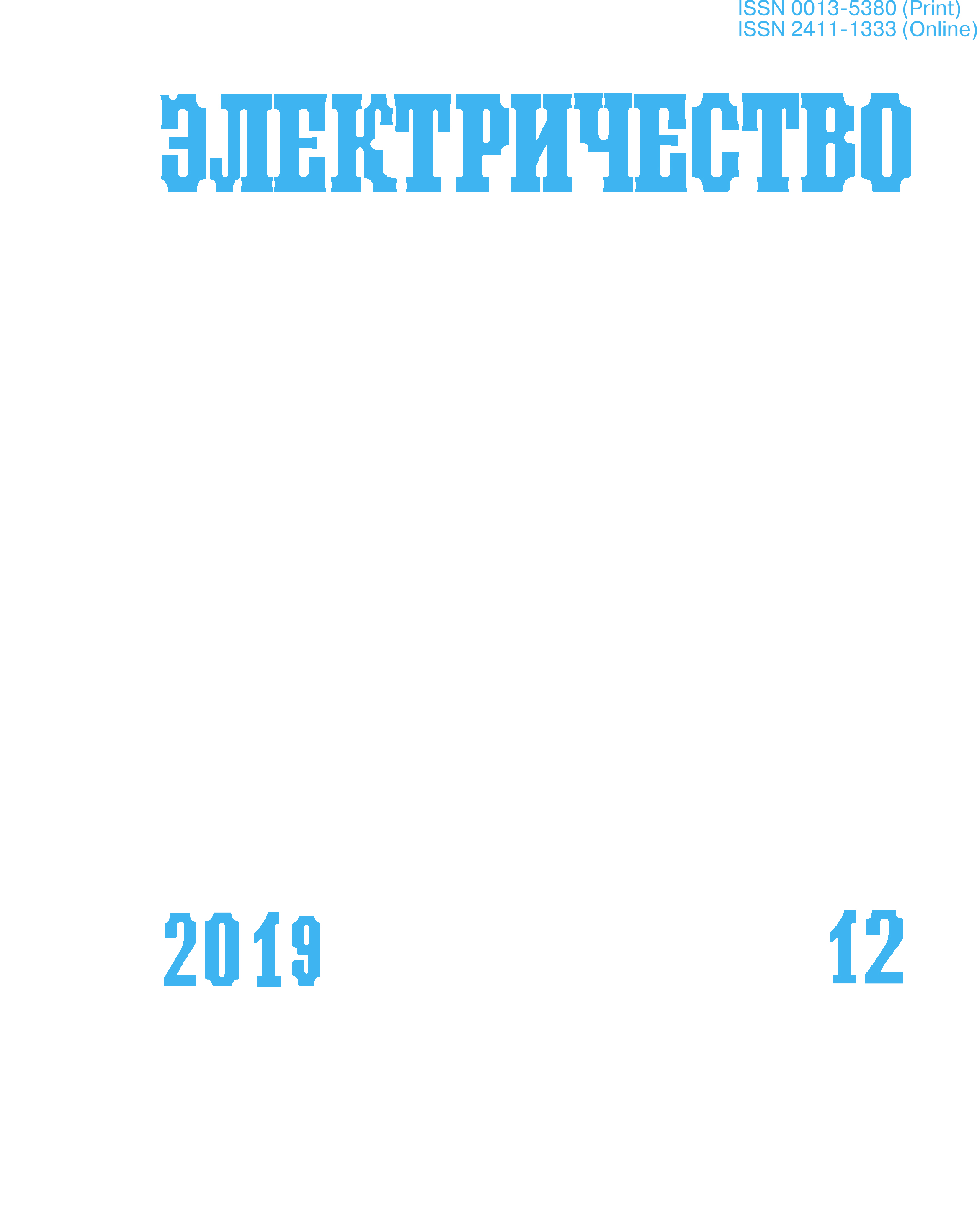Controlling a Semiconductor Converter by Changing the Light Flux
DOI:
https://doi.org/10.24160/0013-5380-2019-12-30-34Keywords:
semiconductor converter, thyristor, optothyristor, photocurrent, rectifier, three-phase bridge circuit, control angleAbstract
Controlling the semiconductor device pnpn-structure switching-on moment by changing the illumination intensity opened the possibility to control the semiconductor structure switching-on delay moment. Such effect can be laid at the heart of a semiconductor converter direct control technology. With such technology, there is no need to have a synchronization unit in the rectifier control system, and it becomes possible to do away with using complex elements. It has been shown experimentally that there is no degradation in the rectifier operation reliability. Experimental data on the scatter in the adjustment characteristics of thyristors taken from the same batch are given. It follows from these data that there is a proportional dependence between the photocurrent and thyristor opening angle, and that there is a proportionality of the current adjustment range in different specimens. By applying the basic electric circuit used in the experiments and using the results from calculating the optothyristor control circuits for the specified output voltage adjustment range, it becomes possible to implement control of the rectifier output proportional to the setpoint (reference) signal. The obtained experimental results can be applied in practice and allow continuous operation modes to be realized, because no failures were recorded during the tests. The temperature drift of the characteristics can be compensated by operation of the control system’s negative feedback. No significant fluctuations of the rectified voltage were recorded, because this mainly depends on the initial control accuracy. The application of this control method is most relevant in high-voltage networks.
References
2. Григорьев О.П., Замятин В.Я., Кондратьев Б.В., Пожидаев С.Л. Тиристоры: справочник. М.: Радио и связь, 1990, 272 с.
3. Силкин Е.И. Оптронные тиристоры в управляемых выпрямителях большой мощности. — Компоненты и технологии, 2009, № 11, с. 79—86.
4. Аверин С.В., Следков Ю.Г. Сравнение способов регулирования переменного напряжения с помощью коэффициента регулирования. — Практическая силовая электроника, 2005, № 20, с. 27—29.
5. Пасынков В.В., Чиркни Л.К. Полупроводниковые приборы. СПб.: Лань, 2002, 480 с.
6. Ансельм А.И. Введение в теорию полупроводников: учебное пос. СПб.: Лань, 2008, 624 с.
7. Волле В.М., Воронков В.Б., Грехов И.В., Лсиинштейн М.Е., Сергеев В.Г., Чашников И.Г. Мощный полупроводниковый коммутатор наносекундного диапазона, управляемый импульсом света. — Электротехника, 1981, № 6, с. 45—47.
8. Евсеев Ю.А. К вопросу о включениирири-структуры светом. — Электротехника, 2006, № 10, с. 19—20.
9. Булатов О.Г., Гуния Р.Г., Дерменжи П.Г., Ковров А.М., Одынь С.В. Влияние режима коммутации на время выключения тиристоров ТБК171. — Электротехника, 1988, № 5, с. 38—43.
10. Беспалов Н.Н., Гейфман Е.М. Экспериментальное исследование площади начального включения и потерь в тиристорах при включении по цепи управления. — Электротехника, 1996, № 1, с. 48—51.
11. Бардин В.М., Пономарев Е.П. Надежность силовых полупроводниковых приборов при работе в циклических режимах. — Электротехника, 1998, № 10, с. 59—61.
#
1. Rybak R.I., Teter’vova N.A., Belaya S.N., Nasekan O.S. Elektrotekhnika — in Russ. (Electrical Engineering), 1988, No. 5, pp. 5-6.
2. Grigor’yev O.P., Zamyatin V.Ya., Kondrat’yev B.V., Pozhidaev S.L. Tiristory: spravochnik (Tiristors: Handbook). Moscow, Radio and svyaz’, 1990, 272 p.
3. Silkin Ye.I. Komponenty i tekhnologii — in Russ. (Komponents and Technologies), 2009, No. 11, pp. 79-86.
4. Averin S.V., Sledkov Yu.G. Prakticheskaya silovaya elektronika — in Russ. (Practical Power Electrical Engineering), 2005, No. 20, pp. 27-29.
5. Pasynkov V.V., Chirkin L.K. Poluprovodnikovye pribory (Semiconductor apparatus). St. Petersburg, Lan’, 2002, 480 p.
6. Ansel’m A.I. Vvedeniye v teoriyu poluprovodnikov: uchebnoe pos. (Introduction to theory of semiconductors: teaching aid). St. Petersburg, Lan’, 2008, 624 p.
7. Volle V.M., Voronkov V.B., Grekhov I.V., Levinshtein M.Ye., Sergeyev V.G., Chashnikov I.G. Elektrotekhnika – in Russ. (Electrical Engineering), 1981, No. 6, pp. 45–47.
8. Yevseyev Yu.A. Elektrotekhnika – in Russ. (Electrical Engineering), 2006, No. 10, pp. 19–20.
9. Bulatov O.G., Guniya R.G., Dermenzhi P.G., Kovrov A.M. Elektrotekhnika – in Russ. (Electrical Engineering), 1988, No. 5, pp. 38–43.
10. Bespalov N.N., Geifman Ye.M. Elektrotekhnika – in Russ. (Electrical Engineering), 1996, No. 1, pp. 48–51.
11. Bardin V.M., Ponomarev Ye.P. Elektrotekhnika – in Russ. (Electrical Engineering), 1998, No. 10, pp. 59–61.




